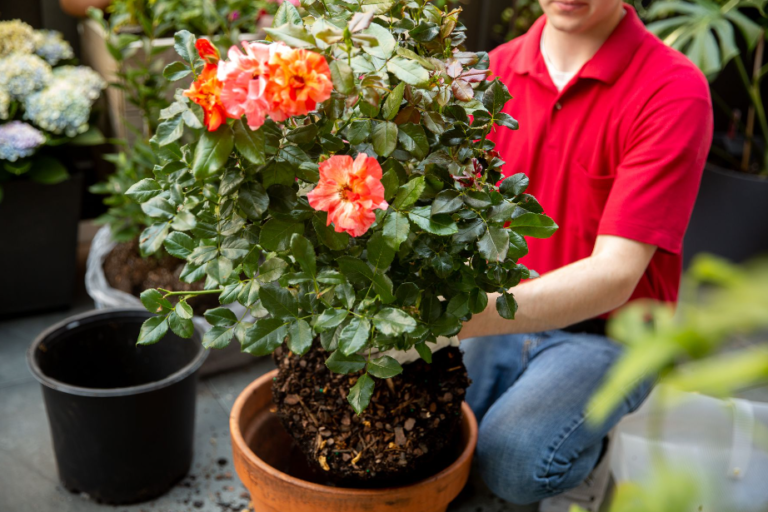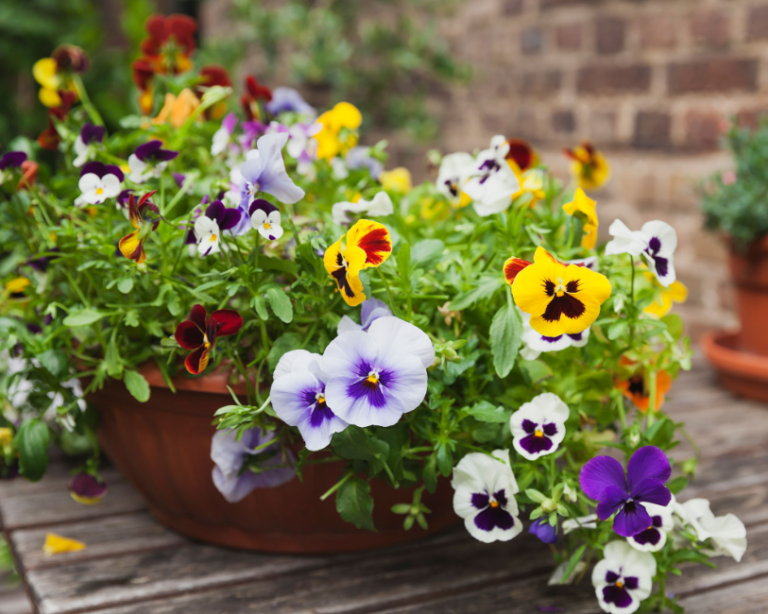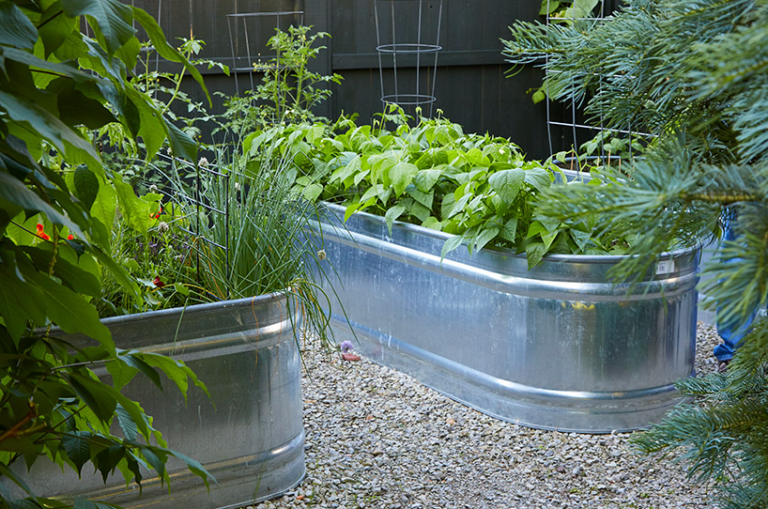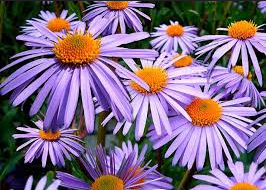Roses dying
Lack of Sun (Potted Roses Require 6 Hours of Direct Light)
All roses require full sun (at least 6 hours) to thrive whether they are planted in full sun or in garden boarders.
The amount of sunlight is directly correlated with the number of flowers a rose displays so if your potted rose is not flowering particularly well then move it to a sunnier location as soon as possible.
A lack of sun is also associated with poor overall growth and the leaves of your potted rose may also turn brown or yellow and begin to drop.

There is no rose variety that grows well in the shade so if you want your potted rose to thrive locate in a nice sunny spot as a matter of urgency and it should start to show signs of reviving within a couple of weeks with new green growth emerging.
Potted Rose with Black spot
There are a host of fungal diseases that affect roses but by far the most common is black spot.
Rose black spot
Black spot on the leaves of a rose.
Black spot is a type of fungus that affects the leaves of your rose with black or brown blotches that can turn the rest of the leaf yellow.
Black spot causes leaf drop reduces flowering and results in the rose generally looks unwell.
Black spot affects all roses but can particualrly be a problem for potted roses if they are crowded with other potted plants or in an area with little airflow around the foliage.
The risk of black spot is increased if you water the rose overhead onto the foliage so ensure that you water your potted rose at the base of the plant.

Whilst an increase in airflow around the foliage can help to mitigate black spot and other fungal diseases that affect roses, it can still be a difficult problem to control as certain weather patterns promote the conditions for fungal disease.
Revive a Potted Rose with Black Spot
Whilst black spot is a common disease for rose growers it can be treated and should not necessarily kill your rose.
Collect any affected leaves of the rose that have fallen due to black spot and burn or discard them.
The spores of the black spot is a fungus spread easier in wet or windy conditions so it is advisable to avoid tending to a diseased rose in damp conditions as it the spores can easily be spread on a pair of gloves or pruners.
Always sterilise pruners after use with disinfectant or alcohol gel to prevent spreading any disease to otherwise healthy plants.
A fungicide spray made specifically for roses from the garden center (or online) is a very effective way of treating black spot.

Generally it can take several applications over the course of a few weeks to treat the fungus but with enough time the rose should revive for the follow years flowering (always follow the manufactures instructions).
Indoor Potted Rose Dying
Indoor miniature roses
Indoor potted roses are very difficult to keep alive for a long simply because roses are a plant that thrives outdoors and at best endures indoor conditions but more often dies.
There are several reasons why your indoor potted rose could be dying:
Not enough light. Roses of all species require at least 6 hours of direct light to flower and thrive. If they are in the shade then they tend to drop leaves, flower poorly and eventually die. Bright, indirect light is not a good enough compromise when growing roses as they really do require direct sun.
Air circulation. Roses are susceptible to several fungal diseases in areas with poor circulation with black spot being the most common. Even when potted roses are outdoors they benefit from being located 3 feet away from other potted plants to encourage air to circulate around the leaves to avoid fungal disease.
Fluctuating temperatures. Roses are specifically adapted to coping with seasonal change and differences in temperatures, sunlight etc. throughout the year. Indoors the temperature can fluctuate drastically in an unnatural way. Roses are accustomed to a cooler evening whereas indoors at night the temperature can increase significantly, particularly if the rose is near a source of heat. This drastic contrast in temperatures can cause leaf drop and is often the cause of a dying indoor rose.
These problems are emphasised when growing potted roses indoors but other factors could also contribute to a dying rose such as under or over watering and root rot due to the use of a tray under the pot which prevents excess water escaping.
How to Revive Indoor Potted Roses
The only way to properly revive indoor potted roses is to move or plant them outdoors which is contrary to their purpose, however roses generally do not thrive when indoors and almost always die.
You can either plant them in the ground in well draing soil rich in organic content or replant the roses in a bigger pot to give them a good chance of reviving.
Usually indoor potted roses do recover when placed back outdoors if they are placed in full sun (more then 6 hours of direct sunlight) watered generously once a week (water potted roses 2 or 3 times a week in hot and dry conditions) and in an are with good circulation to prevent black spot.
A larger pot (at least 12 inches across) provides the rose with enough soil and space for the roots to establish and prevents the soil drying out too quickly.

Trim away any drooping flower heads that are not opening or turning brown so the rose can redirect its energy to new healthy growth.
When placed back outdoors the potted rose should show signs of recover within a week or so.
Key Takeaways:
A dying potted rose is usually because that pot is too small which causes the soil dry out too quickly causing the leaves to wilt or because there are no drainage holes in the base of the pot, causing the rose to die from root rot.
To revive dying potted roses, plant them in a larger pot which has a greater capacity for soil and therefore for moisture and nutrients.
Ensure that the pot has several drainage holes in the base and remove any trays underneath the pot as this stops excess water escaping can cause root rot which is the cause for the dying rose.
Potted roses require full sun and watering at least once per week.
Place indoor potted roses outdoors as they require direct sun and air flow. Potted indoor roses often die because of fluctuating indoor temperatures and less direct light.
Mark Bennett
Recent Posts
link to How to Save a Drooping Aloe Plant
How to Save a Drooping Aloe Plant
The reason for aloe plants with drooping leaves is usually because the aloe is into too much shade. Aloe plants need bright light with some direct sunlight. Aloe plant leaves turn brown and droop due…
CONTINUE READING
link to How to Save a Monstera With Yellow Leaves
How to Save a Monstera With Yellow Leaves
Monstera leaves turn yellow due to both overwatering and underwatering. Overwatering promotes the conditions for root rot, which turns the leaves yellow and brown with a drooping appearance, whereas…






